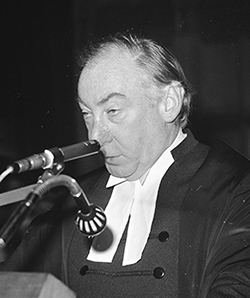Lionel Murphy ‘still an open question’: CSU researcher
Author: Liam Lander
Publication Date: Tuesday, 12 Dec 2017
 A Charles Sturt University (CSU) researcher has examined the highly complex and unprecedented judicial scandal about the conduct of Mr Lionel Murphy, a controversial former left-wing political figure in the Whitlam Labor government and later Justice of the High Court of Australia.
A Charles Sturt University (CSU) researcher has examined the highly complex and unprecedented judicial scandal about the conduct of Mr Lionel Murphy, a controversial former left-wing political figure in the Whitlam Labor government and later Justice of the High Court of Australia.
Earlier in 2017 Mr Liam Lander (pictured), a PhD student in the CSU School of Humanities and Social Sciences initiated an application for access to historic documents that had been embargoed for 30 years. Mr Lander says:
The scandal, which was initiated in February 1984, was founded on illegally obtained police surveillance material that was leaked and published in various Fairfax newspapers, including The Age in Melbourne, and became known as ‘The Age Tapes’.
This material, which contained recordings of various candid telephone conversations, purported that Justice Murphy had conspired with some of Australia’s most notorious organised crime figures.
Additional allegations of corruption against Murphy emerged within the course of a series of Senate inquiries into Murphy’s conduct.
These new allegations, asserted by Chief Stipendiary Magistrate of NSW Clarrie Briese, became the focal issue of the affair. Murphy was subsequently tried and convicted of two counts of the perversion of the course of justice in June 1985 but was acquitted upon a retrial in April 1986.
Coinciding with this verdict however was the report of the Stewart Royal Commission into Alleged Telephone Interceptions, which found that that ‘The Age Tapes’, although factually unreliable were genuine and authentic. This finding reignited public interest in contents of ‘The Age Tapes’.
Once again, the Government established a Parliamentary inquiry to re-examine these materials and determine whether or not Murphy’s conduct warranted his removal from the High court.
Despite a high level of public and political criticism, Murphy refused to resign from the High Court, maintaining a steadfast belief that he was the target of a politicised smear campaign orchestrated by the media
 Murphy (pictured left in 1973) could only be dismissed under section 72 of the Constitution, which states that a Justice of the High Court can only be removed on the basis of proved misbehaviour or incapacity.
Murphy (pictured left in 1973) could only be dismissed under section 72 of the Constitution, which states that a Justice of the High Court can only be removed on the basis of proved misbehaviour or incapacity.
However, the 1986 Parliamentary Commission of Inquiry, which advertised an appeal to the public for information about Murphy, was prematurely terminated due to Murphy’s announcement that he was terminally ill with cancer.
All documents relating to the inquiry were shelved for a minimum period of thirty-years. Following the expiry of this term, these documents have been released to the public in full.
The documents released in September reveal the details of the forty-one matters under examination by the Commission. Among these matters are eight legal opinions relating to various minor infractions committed by Justice Murphy in an official capacity and thirty-three allegations of corruption, misconduct and impropriety spanning Murphy’s two decades in public office.
By the time of its termination, the Commission had drawn allegations relating to fifteen matters and had dismissed twenty-six due to insufficient evidence or no finding of impropriety.
The most outstanding commonality between these allegations were Murphy’s use of underhanded means to secure favourable outcomes for himself, his friends and associates.
Among these are various instances in which Murphy requested special favours, attempted to influence certain governmental and legal proceedings, and obstructed the course of justice. These resulted in the Commission’s recommendation that criminal charges of attempted bribery, conspiracy, and contempt of court be laid against Murphy.
While few of these allegations amounted to actual criminal conduct, it was the view of the Commission that the majority constituted conduct that was contrary to the accepted standards of judicial behaviour.
The revelation of the Commission’s findings detracts significantly from the plausibility of Murphy’s innocence. Nevertheless, it is important to acknowledge the context and conditions in which these allegations emerged.
Murphy’s misconduct was more likely the result of reckless disregard for due process rather than a calculated misuse of public office. Cronyism, patronage and the currency of personal favours had long been commonplace throughout many aspects of Australian society.
However, these practices were challenged by the advent of ‘watchdog journalism’, which increased the need of greater transparency and public accountability in the operation of politics, government, and the administration of justice.
Watchdog journalism had reached its zenith in Australia during the 1980s. Watchdog journalists maintained a strong sense of vigilance, adopting investigative practices in order to expose corruption and injustice for the sake of the public interest.
However, pioneers of this new and more assertive practice of news reporting often pushed legal and professional boundaries in their pursuit of incriminating information. The private lives of the rich and powerful were consequently exposed to an unprecedented degree of scrutiny, resulting in the emergence of a narrower and more clearly defined set of ethical standards for the conduct of public officials.
Despite displays of frequent public apathy towards soft corruption in Australia throughout the 1970s and the 1980s, the adoption by political parties and public institutions of these new ethical standards was necessary if only to avoid the instigation of scandal. Murphy’s conduct did not align with these expectations.
Had circumstances permitted its completion, it is highly likely that, given the Constitutional interpretations adopted by the Commissioners, the inquiry would have resulted in Murphy’s eventual removal from the High Court on the basis of proved misconduct.
Two of the three Commissioners were of the opinion that it was for the Parliament to decide whether or not Murphy’s conduct constituted misbehaviour, while a third assumed a particularly broad definition of proved misbehaviour.
Under these circumstances however, it is unlikely that the Commission would have been the final deliberation in the determination of Murphy’s misconduct.
Since its initiation in February 1984, the Murphy affair had been protracted by several complications.
Most importantly, the ad hoc nature of non-judicial parliamentary inquiries to examine Murphy’s conduct and Murphy’s subsequent refusal to recognise their legal legitimacy, hindered any progress towards a politically satisfactory resolution.
Thus, Murphy’s removal by an act of Parliament would likely not have produced a conclusive outcome to the scandal.
ends
Media contact: Liam Lander, (02) 6338 6084
Media Note:
Contact CSU Media to arrange interviews with Mr Liam Lander.
